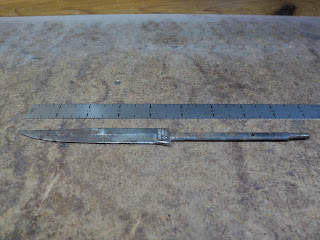
It's quite a nice knife. On the blade it says, "RICH A. HERDER SOLINGEN GERMANY". That firm appears to be no longer with us.
It looks like the knife and sheath got soaked with water, and then neglected. I'll give the sheath a good scrub, set it outside to dry and apply some leather treatment stuff to it.
The knife's handle laminations appear to have shrunk. It looks like the handle can be dismantled. I'll look into that further.
- - -
The sheath cleaned up quite well. It's outside drying.
Here's what I'm up against with the knife's handle.

That round brass item appears to be a nut of sorts that was threaded on to complete the assembly of the handle. The snag is that the end of the male thread appears to have been peened over to lock the nut in place forever.
- - -
It's not the most elegant job that I did of it, but I got it apart without utterly botching it.

I centre punched the threaded 'stud', and drilled away the peening (somewhat -- the drilling ended up being imperfectly centred). The shrunken laminations allowed me to compress the handle and expose enough of the nut's perimeter that I could get a small pair of Vise-Grips on it and start it turning off.
The nut is brass, 10mm in diameter. The thread appears to be M5 x 1.0mm pitch.[!?][1] Here's a view of the entire blade/shank/threaded stud.

At least now I can wire-brush the blade and clean up everything. Reassembly will be straightforward, except for the iffy nut -- getting back to a good appearance at the end of the handle may be a bit challenging.
- - -
Reworking The Threaded Stud
The uncommon thread is a complication. I'll need to make a new nut, but acquiring an M5 x 1.0mm tap is likely to be more expense and aggravation than I'd care to deal with, and I'll be unlikely to ever need the tap again. The thread is so close to 10-24 that I can chase it with a 10-24 die, and give it a 10-24 nut; I'm well-enough equipped to deal with cutting 10-24 threads.
The Nut Blank
Here's a view of the nut blank in the vise about to be threaded.
That's a 28mm length of 10mm diameter steel rod. I've bored it clear through No. 24 (a hair oversize for 10-24 threading). I've bored it out to 7/32" diameter for a depth of 18mm; 7/32" is clearance diameter for the shank of my tap. So, what I have is a blank for a 10mm long nut with built-in guidance for the tap. When the threading is done, I'll cut off the 7/32" bore portion, and I'll have the makings of the nut I need.
10mm is a long way to cut a thread with a tap. I'll need to be extremely careful, and back out the tap and clear away the chips frequently. Here goes.
'Got It
The tap has emerged -- the threading is done. Now I can cut the nut to length, and figure out how to make it 'wrenchable'. (Note the Vise-Grips I had to attach to keep the work from turning in its protective sheet metal in the vise.)
Grinding Parallel Flats
Here's what I came up with to grind two parallel flats on the nut.
That worked remarkably well. The nut now takes a 5/16" open-end wrench. Here's a view of the finished nut.
And here's a view of the nut installed, with the laminated handle properly tightened up.
The downside to this is that I've lost the truly 'finished' appearance of the factory's brass nut. The upside is that I now have a handle termination nut that I can always snug up as needed, should the need arise. The slightly protruding nut doesn't detract from the knife's utility, in any way, shape or form; so I'm not at all ashamed of this repair -- not one little bit.
- - -
All Done
It's back in respectable condition. I'll put it away safely with my camping gear.
- - -
Note:
[1] M5 x 1.0mm pitch is a very uncommon thread. This is the first time I've ever encountered it; it doesn't even appear on my threading data wall chart. It's a bit treacherous, because it looks for all the world like an inch 10-24 thread, and a 10-24 screw runs into an M5 x 1.0mm nut just fine, albeit a bit loosely.
# # #
# # #





